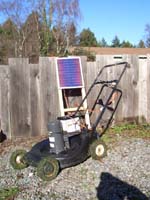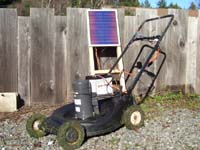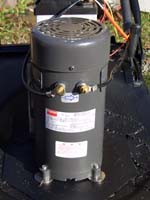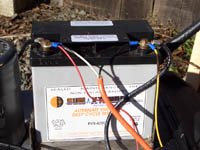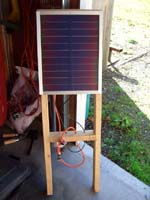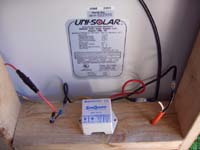Click on images to enlarge
An electric lawnmower that utilizes solar power as an energy source will address a number of issues that standard internal combustion engine mowers do not. An electric lawnmower with a solar charger will be easier to use. There is no messy dangerous gasoline to deal with. It will eliminate those pesky trips to the gas station for fill-ups. Just plug the mower into the charging station when not in use and it will be charged and ready for your next mow! Most importantly it eliminates the emissions of an internal combustion mower.
The basic idea is to convert an older non-working gas mower into an electric powered mower by replacing the gas engine with an electric motor that runs from a 12 volt battery. This battery will be charged using a photovoltaic panel(s) (A.K.A. - solar panel). I chose to convert an old gas mower rather than just starting with an electric mower due to cost and so I could design the power output. I also plan on using as many used materials as I can. This will help to save these materials from ending up in our already over filled landfills.
Click on the links above for more details on building a solar charged electric lawn mower!
I would like to claim that I came up with this solar charged electric mower idea on my own but the truth is I came across an article about one in a "Home Power" magazine (Issue 107) awhile back and have wanted to build one ever since. When the opportunity arose to use it as a project in my Engineering 305 class at Humboldt State University I jumped at the chance.
Motor and Battery Sizing:
To start with I needed to design a mower that would fit my needs. I have a yard that takes about forty-five minutes to mow so it was important to size the battery accordingly. To do this I had to find out what kind of amperage the motor would be pulling for the forty-five minutes it takes to mow the grass. This is dependent on the type of motor used. Motors are rated in HP (horse power) and I wanted around the same HP as a standard internal combustion mower. The newer gas powered lawnmowers are about 4 to 6 HP and the older mowers are around 3 HP. According to the article in "Home Power" magazine 1 HP of an electric motor is equivalent to about 4 HP of an internal combustion engine. I was hoping to purchase a 1 HP motor but after pricing them I decided I needed to go with the least expensive motor that would get the job done. This turned out to be a 12 VDC, 3/4 HP, Dayton electric motor. (See link below for details on parts and cost.)
The 3/4 HP Dayton motor is specified to pull 58A with a full load. I used this figure to help determine the size battery I needed. I knew I wanted a 12VDC battery, they are easy to find, use, and come in a variety of sizes. The next step was to figure out the amp-hours I needed to run this particular motor for 45 minutes. Amp-hours are a measurement of the length of time it takes to discharge a battery at a certain amperage. For example; a 35 amp-hour battery should give 35 amps for an hour before being discharged. I know I want to run my mower for 45 minutes but I'll just round it to an hour to be safe. Although the motor is rated for 58A, that amperage is with a full load and typically while mowing I will not be running a full load. While just spinning the blade (not cutting grass) the amps will only be about half of the full load or 30A. So a 40 Amp-hour battery should allow me to mow moderately tall grass for about 45 minutes to an hour. It just so happens that I had a 40 amp-hour deep-cycle battery from a past project. (See link below for details on parts and cost)
Solar charging station:
After the grass is mowed I'm going to need a way to charge the battery for the next mow. Luckily, my grass only needs to be cut once every week or two. This allows plenty of time to charge the battery with a solar panel. I had originally planned to build a structure that would house the entire mower then mount the solar panel on the roof. Due to time constrains, lack of yard space, and lack of good stationary solar access I decided to build a small portable solar charging station. This will allow me to easily store the mower in the garage while placing the charging station in direct sunlight.
Solar Panel and Charge Controller Sizing:
I have an 11Watt solar panel from a past project that I am using to charge the battery. It is rated at 16.5 operating voltage (Volts) and .62 operating current (Amps) in full sun. (See link below for details on parts and cost)
To figure out how long it takes to charge the battery I use this calculation I found in the owner's manual of a DieHard Battery Charger:
(Amp Hour Rating * % of charge needed / Amps) * 1.25 = hours of charge time
Say my battery is discharged down to 50%, according to my systems setup the calculation would look like this:
(40 Amp-hour battery * .50 charge needed / .62 solar panels Amps) * 1.25 = 40 hours total charge time.
I also have a 12V 4.5A charge controller from a past project. This is wired between the solar panel and the battery. The controller stops the battery from discharging through the solar panel when the sun is not out and the panel is not creating electricity. It also regulates the voltage to the battery. Varying voltage to the battery can significantly shorten the battery's life span. (See link below for details on parts and cost)
Author: Jeremy James
Humboldt State University
Humboldt County, CA
